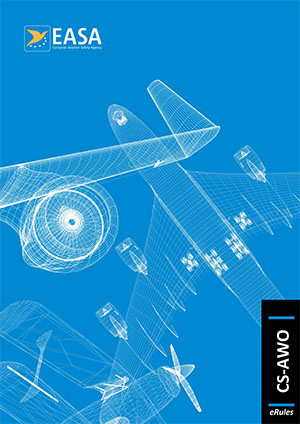CS AWO.C.TOO.101 Applicability
ED Decision 2022/007/R
The certification specifications of this Subpart are applicable to aeroplanes for which certification is sought to allow the performance of take-off in visibility lower than that which is sufficient to ensure that the pilot will at all times have sufficient visibility to complete or abandon the take-off safely. This Subpart is only concerned with directional guidance during the ground-borne portion of the take-off (i.e. from start to main-wheel lift-off, or standstill in the event of abandoned take-off). (See AMC AWO.C.TOO.101)
[Issue: CS-AWO/2]
AMC AWO.C.TOO.101 Applicability and terminology
ED Decision 2022/007/R
An aeroplane with a basic airworthiness approval is eligible for take-off in reported visibility conditions which are sufficient to ensure that the pilot will at all times have sufficient visibility to complete or abandon the take-off safely. The purpose of this Subpart is to specify the supplementary airworthiness criteria for aeroplanes equipped to take off in lower visibility conditions. This Subpart is only concerned with directional guidance during the ground-borne portion of the take-off (i.e. from start to main wheel lift-off, or standstill in the event of abandoned take-off).
The RVR limits for take-off of transport aircraft are set by the responsible national authority in accordance with the applicable operating regulations. The purpose of the guidance system, which is the subject of these requirements, is to permit a reduction of these limits but not to allow a take-off in visibility below the minimum necessary for a normal take-off using visual reference.
The requirements are based on the assumption that, if the take-off guidance system is based on xLS information, operational precautions are taken to ensure that the localiser signal is suitable (e.g. in each case the ILS, the localiser is Category III, or the airborne system has been shown to perform satisfactorily on that installation). For other xLS systems, it should be verified that the runway is covered by the systems’ service volume (e.g. GBAS point).
Terminology
‘Take-off guidance system’: a take-off guidance system provides directional guidance information to the flight crew during the take-off or abandoned take-off. It includes all the airborne sensors, computers, controllers and indicators necessary for the display of such guidance. Guidance normally takes the form of command information, but it may alternatively be situation (or deviation) information.
System concept
The criteria for a take-off guidance system given in the points that follow are intended to provide for a reduction in take-off minima to a level where the pilot can normally line up on the runway centre line and carry out the take-off by visual reference, but where the visibility is sufficiently low that:
(a) any further reduction in the visibility which may be encountered during the take-off run would make directional control by visual reference alone difficult; or
(b) significant deviations from the runway centre line may be difficult to correct by visual reference alone.
Visual reference remains the primary means of guidance, with the system providing reversionary guidance. The pilot would, therefore, not commence the take-off run unless the prescribed visual reference had been acquired and the values of the RVR reported were adequate.
Experience indicates that pilots are able to hold the centre line in very low visibility conditions (e.g. one or two lights visible at one time), and that this ability improves as the speed increases. However, in such low visibility conditions, the pilot may over-control in attempting to return to the centre line if the aeroplane deviates for any reason, and the reducing speed of an abandoned take-off may be the most critical phase in this respect.
[Issue: CS-AWO/2]
CS AWO.B.RRVR.101 Applicability
ED Decision 2022/007/R
The safety level in take-off in low visibility shall not be less than the average safety level achieved in take-off in good visibility.
[Issue: CS-AWO/2]
AMC AWO.C.TOO.102 Safety level
ED Decision 2022/007/R
In showing compliance with the performance and failure requirements, the probabilities of performance or failure effects may not be factored by the proportion of take-offs performed in low visibility conditions.
[Issue: CS-AWO/2]
CS AWO.C.TOO.103 Guidance information
ED Decision 2022/007/R
The take-off guidance system shall provide guidance information which will, in the event of loss of visual references during the take-off, enable the pilot to control the aeroplane to the runway centre line during the take-off or abandoned take-off using the normal steering controls. Its use shall not require exceptional piloting skill or alertness.
[Issue: CS-AWO/2]
CS AWO.C.TOO.104 Guidance display
ED Decision 2022/007/R
(a) The take-off guidance information shall be provided in such a form that it is immediately usable by the pilot who performs the take-off. Its use shall not require the pilot to refer to the instrument panel for this information, nor shall it require the other pilot to take control of the aeroplane. Reversion to the system shall be easy and natural.
(b) The information display shall be usable in all appropriate conditions of ambient light, runway lighting and visibility.
(c) The system shall be designed to minimise crew errors. (See AMC AWO.C.TOO.104(c))
[Issue: CS-AWO/2]
AMC AWO.C.TOO.104(c) Guidance display
ED Decision 2022/007/R
The system should be so designed that it is obvious whether the pilot has not taken all the actions necessary for its correct operation.
[Issue: CS-AWO/2]
